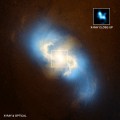The fastest wind ever discovered blowing off a disk around a stellar-mass black hole has been observed by a team of astronomers using NASA’s Chandra X-ray Observatory, an orbiting telescope. They clocked the record-breaking super wind at about 20 million mph, or about 3 percent of the speed of light. This is nearly 10 times faster than astronomers had previously observed from a stellar-mass black hole.
“This is like the cosmic equivalent of winds from a category five hurricane,” said Ashley King of the Department of Astronomy at the University of Michigan, lead author of the study published in the Feb. 20 issue of The Astrophysical Journal Letters. “We weren’t expecting to see such powerful winds from a black hole like this.”

This artist’s impression shows a binary system containing a stellar-mass black hole called IGR J17091-3624, or IGR J17091 for short.
NASA’s Marshall Space Flight Center in Huntsville, Ala., manages the Chandra program for NASA and the Smithsonian Astrophysical Observatory controls Chandra’s science and flight operations from Cambridge, Mass.
The result has important implications for understanding how this type of black hole behaves. Stellar-mass black holes are born when extremely massive stars collapse. They typically weigh between five and 10 times the mass of the sun.
The stellar-mass black hole powering this super wind is known as IGR J17091-3624, or IGR J17091 for short. Located in the bulge of the Milky Way galaxy, about 28,000 light years away from Earth, it is a binary system in which a sun-like star orbits the black hole.
The wind speed in IGR J17091 matches some of the fastest winds generated by supermassive black holes, objects millions or billions of times more massive.
Another unanticipated finding is that the wind, which comes from a disk of gas surrounding the black hole, may be carrying away more material than the black hole is capturing.
Astronomers believe that magnetic fields in the disks of black holes are responsible for producing the winds. —Source: University of Michigan





